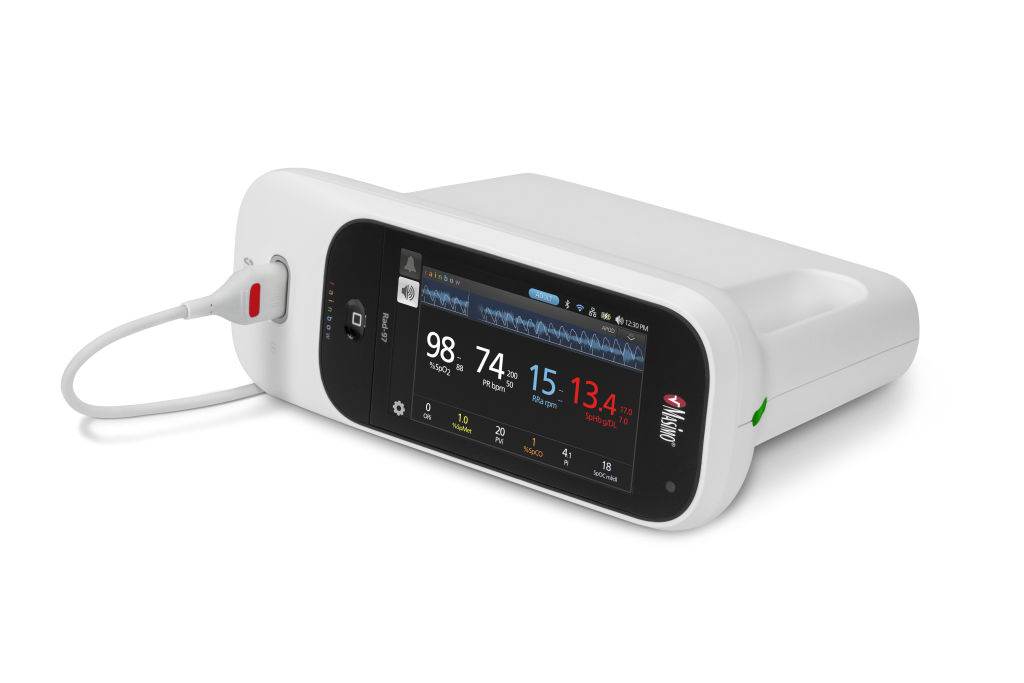The pulse oximetry ‘epidemic’, or the limitations of pulse oximetry
Pulse oximetry in practice
Pulse oximetry first became available in the mid-1980s and has since become the most common form of medical electronic monitoring. It has far outstripped electrocardiography (ECG) as the pulse oximeters are cheap to produce and easy to apply. However useful they may appear, in the vast majority of situations, clinical decisions are made by those who have no idea of the limitations and consequent dangers in interpretation of arterial haemoglobin oxygen saturation (SaO2) as estimated by pulse oximetry (SpO2). SpO2 refers to the oximeter reading which indicates the percentage of blood that is saturated with oxygen, which means that it may differ from the actual SaO2 level.
In most cases, medical professionals must be included in this failure. Pulse oximetry is based upon spectrophotometric absorption at two wavelengths, 660nm and 940nm (red and near infrared) and photoplethysmography (an optical measurement method to monitor heart rate). The table below categorises the limitations of pulse oximetry. The column entitled SAFE lists the limitations which make themselves apparent because either an alarm is activated, no SpO2 value is indicated, or there is a failure of any plethysmograph trace. The DANGEROUS column lists problems where the there is no indication that the SpO2 value is incorrect.

This blog focuses on the dangerous limitations of pulse oximetry, and to the two most significant and misunderstood problems: abnormal haemoglobins and powerful LED lighting.
LED lighting
Any bright ambient lighting can upset pulse oximeters by ‘flooding’ the device. This becomes a particularly pertinent problem if the light source is variable intensity Light Emitting Diode (LED) lighting. LED lighting normally flickers at a rate of more than 200Hz, using pulse width modulation to control the intensity. The actual intensity is narrow pulses of adjustable width at the same frequency high frequency. The human eye sees this flicker as a continuous light of variable brightness; the pulse oximeter ‘sees’ these short pulses at the same high brightness, this problem with its ‘vision’ upsets the pulse oximeter’s calculations.
Abnormal haemoglobins
Of much greater concern are abnormal haemoglobins which have different light absorbent spectra than normal adult human haemoglobin, HbA. Conventional pulse oximeters, both cheap and expensive, use just two wavelengths of energy (660nm or ‘red’, and 940nm or ‘near infra-red’). Two-wavelength pulse oximeters are calibrated for HbA. The most significant abnormal haemoglobin is carboxyhaemoglobin (COHb), which is when carbon monoxide has been inhaled and subsequently combined with haemoglobin. For each percentage point of circulating COHb, a conventional two-wavelength pulse oximeter over-reads to value of Sp02 = approximately SaO2% + %COHb. Apart from rare medical causes (haemolytic anaemia), carboxyhaemoglobin is generated as previously mentioned, through the inhalation of carbon monoxide. Common causes of carbon monoxide inhalation are the incomplete combustion of hydrocarbons listed below:
- Tobacco smoking
- Petrol engine exhaust (accidental or suicide)
- Faulty gas central heating
- Cooking over gas
- BBQs
- Pizza ovens
- Fire pits in the garden
- Building conflagrations
- Wood fires
- Fast-food grills
- Paraffin heating stoves
- Road Traffic Accidents
For example, a 20-cigarette-per-day smoking habit may induce an 8% concentration of circulating carboxyhaemoglobin, making a conventional two-wavelength pulse oximeter over-read by that additional 8%. Heavy smokers have been known to have >30% COHb. It has also recently been reported that there are approximately 50 deaths per annum from carbon monoxide poisoning involving BBQs. The reliance of conventional pulse oximeters by medical professionals should never be used on individual patients until it can be determined that there is no circulating carboxyhaemoglobin. This is especially important in emergency situations, such as in ambulance or Accident and Emergency departments.
Multi-wavelength CO-pulse oximeters
Fortunately, there are a range of so-called CO-pulse oximeters which use more than two wavelengths and are therefore able to distinguish between abnormal haemoglobins. Unfortunately, they are more expensive, but only one such device would be necessary per A&E department to check that patients have no circulating COHb, before using a conventional two-wavelength pulse oximeter.

The photograph shows multi wavelength pulse oximeters in the Rainbow® range of the Masimo Corporation. They use seven wavelengths for detection and are able to estimate COHb with an accuracy of +/-1.5% (as well as Perfusion Index (Pi), Total Haemoglobin (SpHb®), Oxygen Content (SpOC™), Oxygen Reserve Index (ORi™), Pleth Variability Index (PVi®), Methaemoglobin (SpMet®), Carboxyhaemoglobin (SpCO®), Acoustic Respiration Rate (RRa®), Respiration Rate from the Pleth (RRp®)).
‘Delay’ refers to how long a particular pulse oximeter take to respond to a change in arteriolar SO2. This delay may be due to the plethysmogram signal decreasing in amplitude due to a weakening pulse or an arrythmia; many older devices were slow in showing a change in SpO2 level until the plethysmogram trace stabilised.
There has been much discussion in the medical press about inaccuracies in SpO2 measurement in heavily pigmented skin. Recent evidence shows this is not a problem in the more expensive range of pulse oximeters especially those that use Masimos’s SET® (Signal Extraction Technology) which is employed in Masimo’s range of pulse oximeters and many other OEM devices.
Pulse oximeters are incredibly useful devices, but only when all their limitations are considered and accounted for.
References
Written By
Dr John Moyle
Retired Chartered Engineer & Anaesthetist
Contact Details
Email: drjmoyle@gmail.com
Telephone: +447836244584